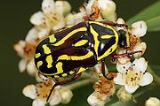
Eupoecila australasiae
Encyclopedia
Eupoecila australasiae, commonly known as the fiddler beetle or rose chafer, is a colourful green- or yellow-and-black member of the scarab beetle
family from eastern Australia.
The fiddler beetle was originally described by Anglo Irish naturalist Edward Donovan
as Cetonia australasiae in his 1805 work An Epitome of the Natural History of the Insects of New Holland, New Zealand, New Guinea, Otaheite, and other Islands in the Indian, Southern, and Pacific Oceans. It was reclassified in and became the type species
of the new genus Eupoecila by German entomologist Hermann Burmeister
in 1842. Within the scarab family, it is a member of the subfamily Cetoniinae, commonly known as flower chafer
s. These beetles are strong flyers and can fly without moving the elytra; they spend much of the time searching for nectar and plant exudates.
Its common name is derived from its patterned body, reminiscent of a violin
.
The fiddler beetle measures 15–20 mm (0.590551181102362–0.78740157480315 ) in length, its body patterned dark brown and lime green to yellow.
It is found in eastern Australia, in Queensland, New South Wales, Victoria, and southeastern South Australia, and lives in heathland and eucalypt woodland, as well as suburban parks and gardens.
Eggs are laid in rotting logs, or in debris or soil. The larvae eat rotting wood until they mature and pupate there by making a cocoon-like chamber within the wood. Adult beetles burrow through the soil and emerge in early summer, and feed on nectar-laden flowers. These include Angophora woodsiana, Backhousia citriodora, and Melaleuca linariifolia
.
Scarabaeidae
The family Scarabaeidae as currently defined consists of over 30,000 species of beetles worldwide. The species in this large family are often called scarabs or scarab beetles. The classification of this family is fairly unstable, with numerous competing theories, and new proposals appearing quite...
family from eastern Australia.
The fiddler beetle was originally described by Anglo Irish naturalist Edward Donovan
Edward Donovan
Edward Donovan was an Anglo Irish writer, natural history illustrator and amateur zoologist.-Biography:Born in Cork, Ireland, Donovan was an avid collector of natural history specimens purchased mainly at auctions of specimens from voyages of exploration...
as Cetonia australasiae in his 1805 work An Epitome of the Natural History of the Insects of New Holland, New Zealand, New Guinea, Otaheite, and other Islands in the Indian, Southern, and Pacific Oceans. It was reclassified in and became the type species
Type species
In biological nomenclature, a type species is both a concept and a practical system which is used in the classification and nomenclature of animals and plants. The value of a "type species" lies in the fact that it makes clear what is meant by a particular genus name. A type species is the species...
of the new genus Eupoecila by German entomologist Hermann Burmeister
Hermann Burmeister
Karl Hermann Konrad Burmeister was a German zoologist, entomologist, and herpetologist.Burmeister was born in Stralsund and became a professor of Zoology at the Martin Luther University of Halle-Wittenberg from 1837 to 1861...
in 1842. Within the scarab family, it is a member of the subfamily Cetoniinae, commonly known as flower chafer
Flower chafer
Flower chafers are a group of scarab beetles, comprising the subfamily Cetoniinae. Many species are diurnal and visit flowers for pollen and nectar, or to browse on the petals. Some species also feed on fruit. The group is also called fruit and flower chafers, flower beetles and flower scarabs...
s. These beetles are strong flyers and can fly without moving the elytra; they spend much of the time searching for nectar and plant exudates.
Its common name is derived from its patterned body, reminiscent of a violin
Violin
The violin is a string instrument, usually with four strings tuned in perfect fifths. It is the smallest, highest-pitched member of the violin family of string instruments, which includes the viola and cello....
.
The fiddler beetle measures 15–20 mm (0.590551181102362–0.78740157480315 ) in length, its body patterned dark brown and lime green to yellow.
It is found in eastern Australia, in Queensland, New South Wales, Victoria, and southeastern South Australia, and lives in heathland and eucalypt woodland, as well as suburban parks and gardens.
Eggs are laid in rotting logs, or in debris or soil. The larvae eat rotting wood until they mature and pupate there by making a cocoon-like chamber within the wood. Adult beetles burrow through the soil and emerge in early summer, and feed on nectar-laden flowers. These include Angophora woodsiana, Backhousia citriodora, and Melaleuca linariifolia
Melaleuca linariifolia
Melaleuca linariifolia, popularly known as Snow-in-Summer, is a plant native to eastern Australia. Other names include Narrow-leaved Paperbark, Flax-leaved Paperbark and the Gadigal Budjur....
.

